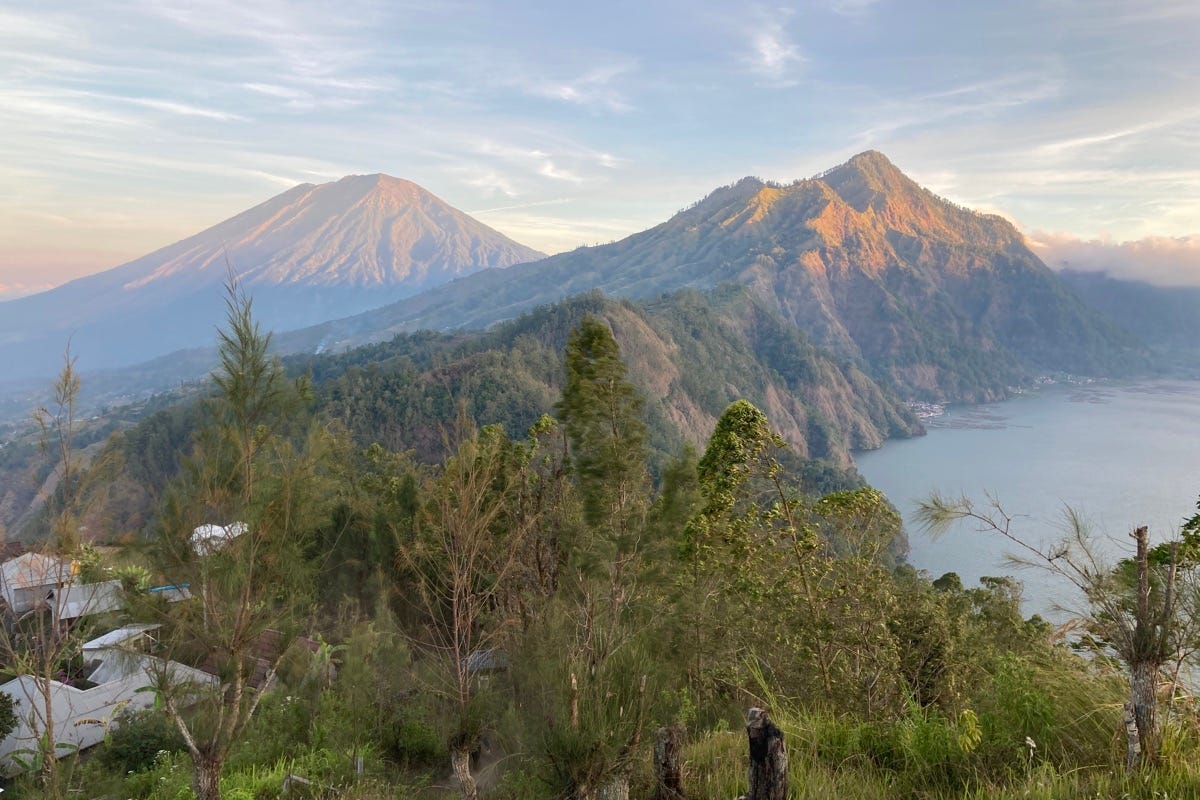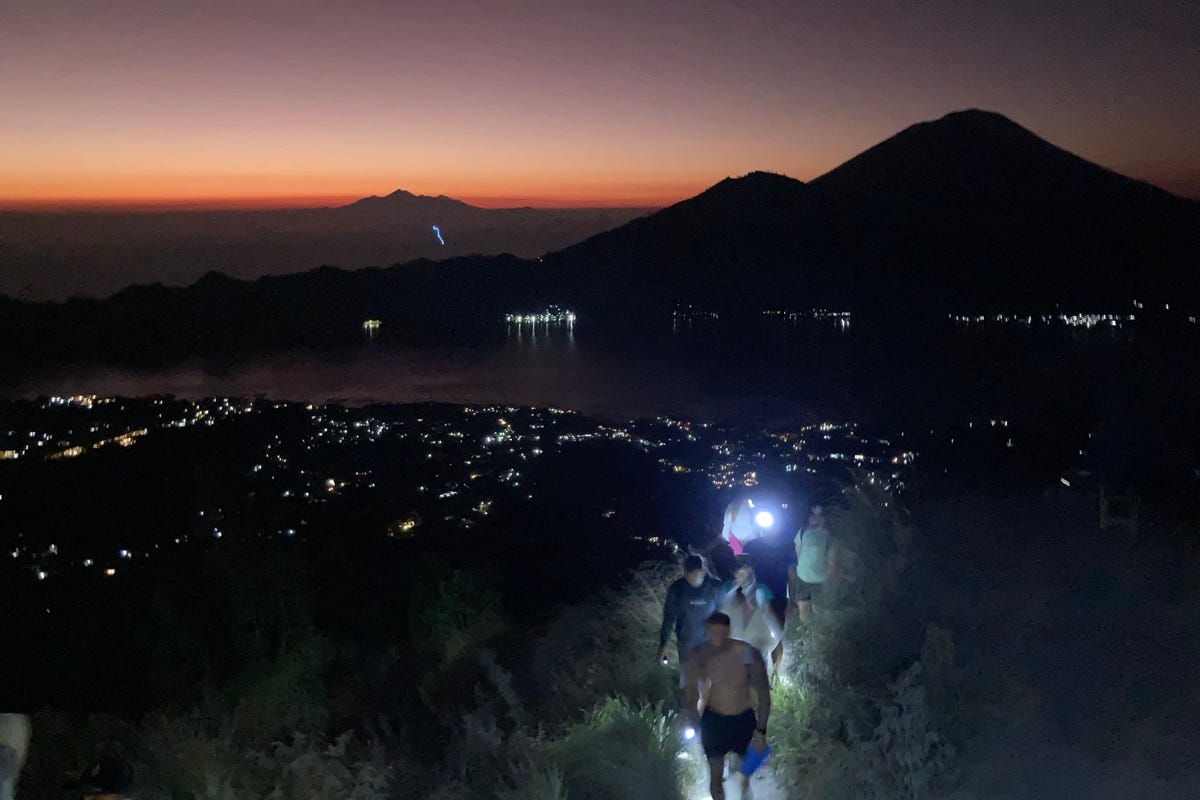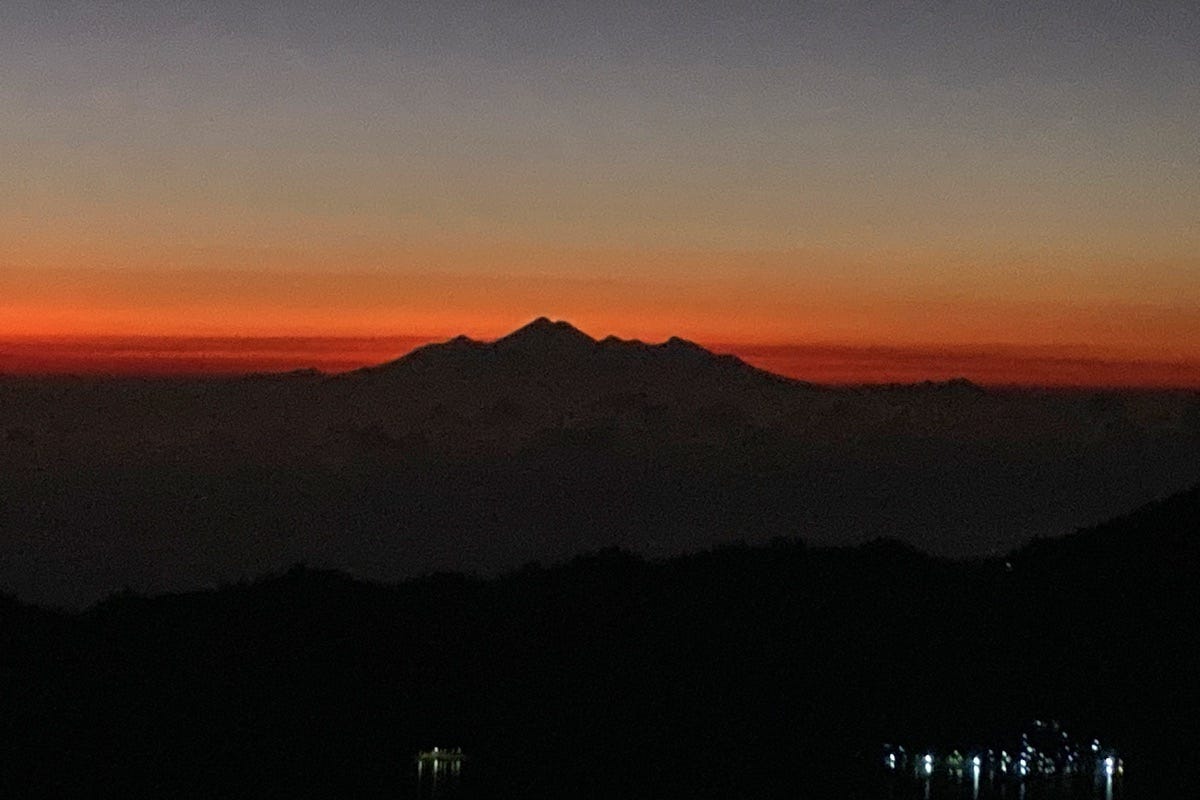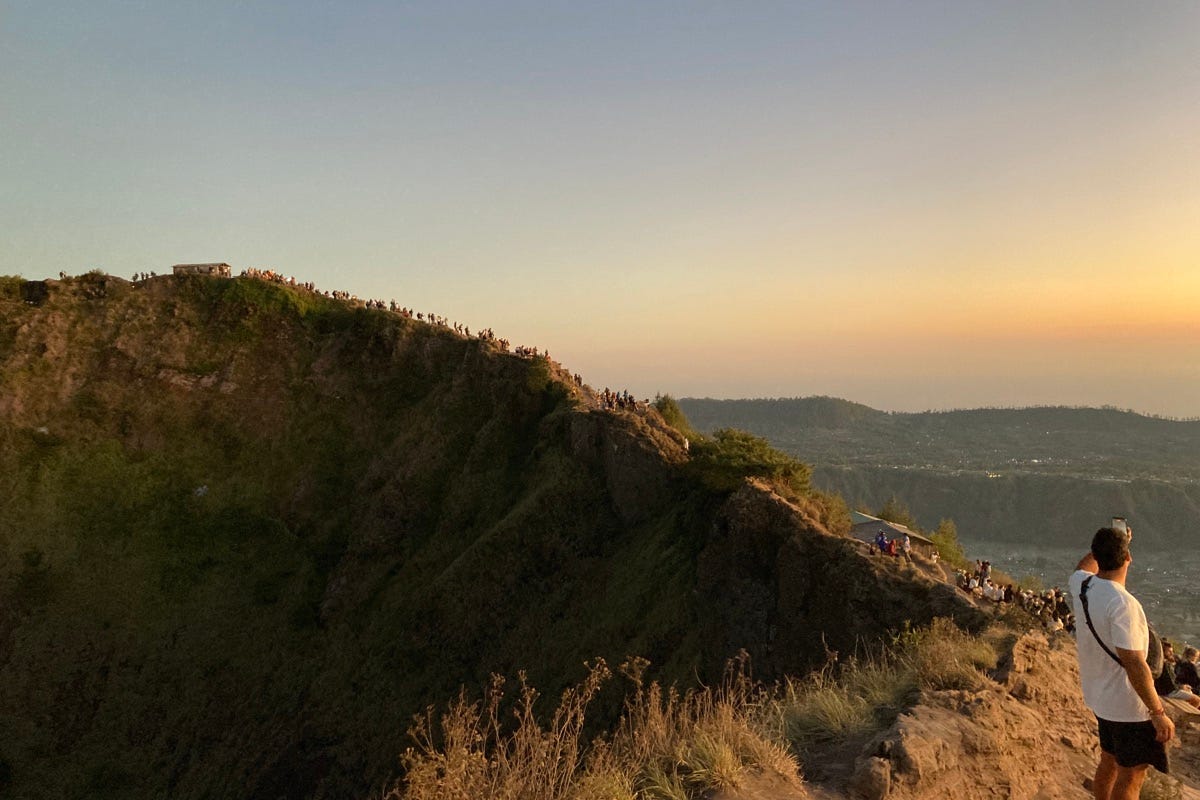A quick word of introduction. My name is Stuart McDonald and this is Couchfish—the perfect tub of ice-cream for the traveller stranded on the couch. The newsletter has both a paid edition which traces a fantasy itinerary through Southeast Asia, and a free one that covers, well, everything else.
This is a two-part series, with the conclusion tomorrow. Today I’m looking at the stories behind Bali’s Mount Batur and what the trekking experience can be like today. Tomorrow, some thoughts on how perhaps the visitor experience could be better managed. Both pieces are free-to-read, but if you’d like to support me finding more tourism stuff to moan about, please consider becoming a paid subscriber. Thank you.
Situated in the northern reaches of Bali, Mount Batur is a 1,717 metre peak at the centre of an enormous caldera. Thought to have once towered to some 3,000 to 4,000 metres, two tremendous eruptions some 20,000 to 30,000 years ago halved its height. Still active, the volcano has over two dozen recorded eruptions to its name, with the lava of a 1960s eruption still blanketing the caldera floor. While nearby Mount Agung may be the better known, Batur is easily the most popular to climb.
Sunset from the caldera rim, with Mount Agung in the distance. Photo: Stuart McDonald.
Batur has two creation myths to its name. One holds that Bali was once a free-floating—dare I say free-thinking—island, cruising the ocean’s surface. Hanging out on Mount Semeru, this bothered the gods, so they decided to anchor it in place. To do so, they shifted Semeru’s peak to Bali, breaking it in two, with Agung forming the male half and Batur the female.
The better tale also harks back a bit, to the days when a giant named Kebo Iwa called Bali home. No, he wasn’t named after the Nusa Penida fast boat that sank last year, though there are some interesting angles on his name here. A kind-hearted soul, he was gargantuan in both size and appetite, and when his tummy rumbled, his temper flared. After a bad rice harvest one year, famine ravaged the island and the Balinese didn’t have enough to satisfy his appetite. He spat the dummy and smashed the place up, filling his belly with villagers rather than whatever it was giants ate back then.
Sunset with Batur at the centre. The lake in the foreground was Kebo Iwa’s undoing. Photo: Stuart McDonald.
For the people, this was a bummer and they came up with a plan to deal with their giant man-child once and for all. Once he chilled out, they convinced him to amend for his tantrum and fix stuff up, which he did. When it came to sorting out some water, the villagers pointed him to north Bali and asked he dig a well. Digging and digging, deeper he went, all the while the mound of displaced earth growing. As he dug, the villagers piled limestone on the other side of the well. When he struck water, they’d build him a house to say thanks, they told him. This pleased Kebo Iwa.
When he finally struck water, the giant figured he deserved a bit of a kip and took a nap in the bottom of the well. The villagers, seeing him snoozing, threw the limestone in around him, where it mixed with the water, turning to a gooey paste. When the giant awoke, he realised something was up and threw another tantrum, but all he got for his efforts was for the mushy limestone to hold him fast. The water gushed in and poor old Kebo Iwa drowned. When the water ebbed, Lake Batur took shape and the giant’s mound of earth became Mount Batur.
Moral of the story: Don’t sleep at the bottom of a well—particularly if your so-called mates are stacking up limestone by the side.
Late arrivals. Note the very suitable mountain climbing attire by the shirtless guy in front. Trekkers were this close almost the whole way up. Photo: Stuart McDonald.
Mount Batur forms the centrepiece of the Batur UNESCO Global Geopark. Designated in 2015, the park encompasses over 370 km2, with famous-for-its-coffee-and-touts Kintamani, perched on the caldera’s southern rim. A popular destination for both local and foreign tourists, some come for the cool climate and coffee, others for the majestic views or hot springs. A growing number though, come to climb—as I did with my son and a mate of his, on Saturday morning.
A tiny family-owned homestay in Banjar Alengkong on the caldera’s northeast ridge, was our home for the night. As the sun fell, we enjoyed magnificent views across to Mount Agung to the east and Batur to the south. Later, we warmed ourselves by the fire as a million stars twinkled above. If this weather holds, we’re up for a good climb, I remember thinking.
The homestay was a thirty minute drive from where we would start climbing at Pura Pasar Agung. From there, as the crow flies, it is less than a kilometre to the rim—about an hour and a half climb according to our guide. Many though, begin their trek two and a half kilometres—or 45 minutes on foot—earlier, from the main road. When I say many, I mean ... many.
The silhouette of Rinjani never disappoints. The weather could not have been better—perfection. Photo: Stuart McDonald.
Along that drive, while I wasn’t counting, I reckon we passed close to five hundred people. Western guys shone torches in our driver’s face and yelled “cheaters” as we drove by. Sorry we didn’t walk from Kerobokan fellas. I knew Batur was popular, but I didn’t expect crowds of this scale, and at the temple parking lot, I realised I hadn’t seen anything yet. Trekkers thronged by the temple, and in the distance, their torches illuminated the entire trail to the summit.
The climb wasn’t too hard. I worked up a bit of a sweat, and some panting occurred, but compared to climbing Agung, it’s a walk in the park. What made it a chore—not only a chore, but dangerous—were the crowds. When climbing, you want some distance between people—for slips, dislodged rocks and so on—yet here people were on top of one another. If I slowed to allow for a few metres between the next trekker and myself, some impatient would barge past, inserting themselves into the gap. I’d say for the first hour of the climb, I had someone else’s boots in my immediate field of vision the entire time. People fell and slipped, rocks flew, and tempers frayed—it was not ideal.
Around 100 people (that I can count in the photo, there were far more down the slope to the right etcetera) strung out along the first quarter of the rim. They lined the rim in this manner the entire way around. Photo: Stuart McDonald.
In summary—it sucked. It made for both a crap experience, and an unsafe one. Nevertheless, the three of us and our guide reached the rim in good time, with a half hour to spare before dawn.
I wandered the start of the rim and witnessed the most unexpected of scenes. Guitars strummed, as did music from smart phones. Vendors flogged beer, coffee, snacks, and polished lava bracelets. Aloft, at least a half dozen drones buzzed, and there were selfies aplenty.
A crowd of hundreds, predominantly foreign, were setting up along a series of terraces hewn into the rim. Along each, simple wooden benches allowed for more comfortable seating. In other bench-less areas people marked out their territory much as you would a tract of sand by the sea. Across the peak, the entirety of the rim—with a circumference of almost a kilometre—glowed with trekker torches. By the time the sun rose behind Mount Rinjani on Lombok, there had to be at least a thousand people at the summit. Together we waited for sunrise.
Finally, some Indonesian climbers—the red and white always gives them away! Photo: Stuart McDonald.
I turned to our guide and asked if it was always this busy. They shook their head saying:
“It is much worse in August when we have to start at 1 am to get a seat.”
We’d stumbled onto a volcanic beach party.
Tomorrow, some thoughts on some alternative approaches to visitor management at Batur—and elsewhere. Not only to improve the visitor experience but also to protect both local peoples’ livelihoods and to better act to respect their faith.
Couchfish is 100 per cent independent and reader-supported. If you’re not already a subscriber, and you’d like to show your support, become a paying subscriber today for just US$7 per month—you can find out more about Couchfish here—or simply share this story with a friend.
Don’t forget, you can find the free podcasts on Apple, Pocket Casts and Spotify as well as right here on Couchfish.
















